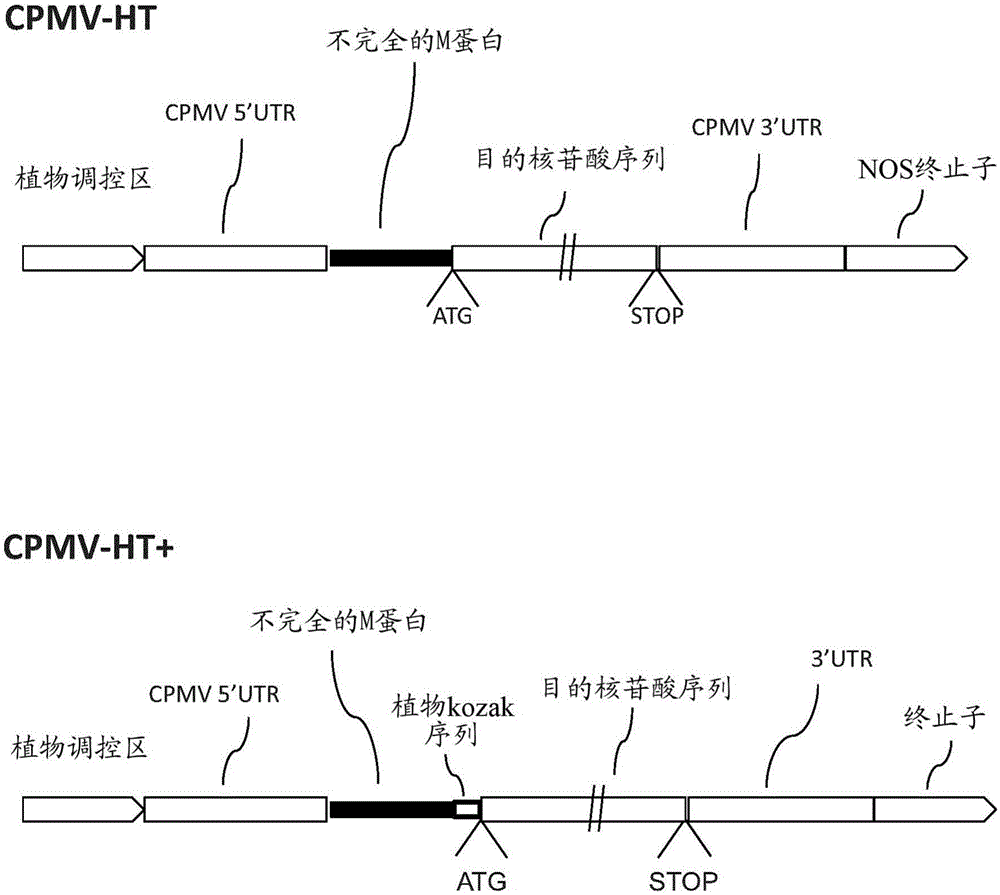Modified CPMV enhancer elements
A purpose and promoter technology, applied in the direction of angiosperms/flowering plants, allergic diseases, peptide sources, etc., can solve the problems of virus biological protection concerns, limit the size of inserted sequences, etc.
- Summary
- Abstract
- Description
- Claims
- Application Information
AI Technical Summary
Problems solved by technology
Method used
Image
Examples
Embodiment 1
[0236] Example 1: 2X35S / CPMV-HT / PDISP / H3 Victoria / NOS (Construct No. 1391)
[0237] The sequence encoding H3 from influenza virus A / Victoria / 361 / 2011 (PDISP / H3 Victoria) in which the native signal peptide has been replaced by the signal peptide of the alfalfa protein disulfide isomerase was cloned into 2X35S using the following PCR-based method - CPMV-HT-NOS expression body. Using primers IF-PDI.S1+3c (Figure 5A, SEQ ID NO:18) and IF-H3V36111.s1-4r (Figure 5B, SEQ ID NO:19), using the PDISP / H3 Victoria sequence (Figure 5C, SEQ ID NO:20) was used as a template to amplify the fragment containing the coding sequence of PDISP / H3 Victoria. PCR products were cloned into the 2X35S / CPMV-HT / NOS expression system using the In-Fusion cloning system (Clontech, Mountain View, CA). Construct number 1191 was digested with SacII and StuI restriction enzymes ( Figure 5D and 5E , SEQ ID NO:21), and the linearized plasmid was used in the In-Fusion assembly reaction. Construct number 1191...
Embodiment 2
[0238] Example 2: 2X35S / CPMV-HT+ / PDISP / H3 Victoria / NOS (Construct No. 1819)
[0239] The sequence encoding H3 from influenza virus A / Victoria / 361 / 2011 (PDISP / H3 Victoria) in which the native signal peptide has been replaced by the signal peptide of the alfalfa protein disulfide isomerase was cloned into 2X35S using the following PCR-based method - CPMV-HT+ / NOS expressor. Using primers IF(SacII)-Kozac_PDI.c (Figure 6A, SEQ ID NO:24) and IF-H3V36111.s1-4r (Figure 5B, SEQ ID NO:19), using the PDISP / H3 Victoria sequence (Figure 8C, SEQ ID NO:19) IDNO:20) was used as a template to amplify a fragment of the PDISP / H3 Victoria coding sequence. PCR products were cloned into the 2X35S / CPMV-HT+ / NOS expression system using the In-Fusion cloning system (Clontech, Mountain View, CA). Construct number 2181 (Figure 6B) was digested with SacII and StuI restriction enzymes, and the linearized plasmid was used in an In-Fusion assembly reaction. Construct number 2181 is a recipient plasmid d...
Embodiment 3
[0240] Example 3 SacII restriction site and PDISP / H3 in 2X35S / CPMV HT+ / NOS expression system Sequence changes between Victoria's ATGs (construct numbers 1952 to 1959)
[0241] Utilizing the same PCR-based approach as construct number 1819 (see Example 2), with a modified forward primer and keeping all other steps the same, eight SacII-restricted cells containing the 2X35S / CPMV HT+ / NOS expression system were created. Constructs with sequence changes between sites and the ATG of PDISP / H3Victoria. Variants HT1* to HT8* were amplified using the primers listed in Figures 7A-7H to create construct numbers 1952 to 1959, respectively:
[0242] IF-HT1*(-Mprot)-PDI.c (FIG. 7A, SEQ ID NO:27),
[0243] IF-HT2*(-Mprot)-PDI.c (FIG. 7B, SEQ ID NO:28),
[0244] IF-HT3*(-Mprot)-PDI.c (FIG. 7C, SEQ ID NO:29)
[0245] IF-HT4*(-Mprot)-PDI.c (FIG. 7D, SEQ ID NO:30)
[0246] IF-HT5*(-Mprot)-PDI.c (FIG. 7E, SEQ ID NO:31)
[0247] IF-HT6*(-Mprot)-PDI.c (FIG. 7F, SEQ ID NO:32)
[0248] IF-HT...
PUM
 Login to View More
Login to View More Abstract
Description
Claims
Application Information
 Login to View More
Login to View More - R&D
- Intellectual Property
- Life Sciences
- Materials
- Tech Scout
- Unparalleled Data Quality
- Higher Quality Content
- 60% Fewer Hallucinations
Browse by: Latest US Patents, China's latest patents, Technical Efficacy Thesaurus, Application Domain, Technology Topic, Popular Technical Reports.
© 2025 PatSnap. All rights reserved.Legal|Privacy policy|Modern Slavery Act Transparency Statement|Sitemap|About US| Contact US: help@patsnap.com



